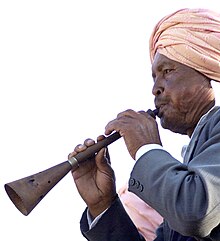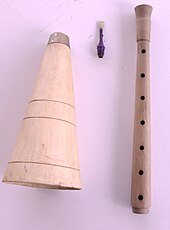Tangmuri
Tangmuri (in the Khasi language ka tangmuri ) is a double-reed instrument with a conical bell , which is played by the indigenous people of the Khasi in the northeast Indian state of Meghalaya to accompany entertainment dances and on happy festive occasions.
Design
The tangmuri consists of a wooden play tube about twenty centimeters long with seven finger holes on the top. This is extended by a fifteen centimeter long, conical wooden bell that is removable. The short double reed is placed on a three centimeter long conical metal tube that is wrapped with a cord so that it can be pushed windproof into the end of the play tube. The musician operates the three upper finger holes with his left hand and the four lower holes with his right hand. The instrument has a high-pitched, penetrating, sharp sound. The word component muri means “drain” or “(water) drain” in Khasi.
distribution
In large parts of Asia, cone oboes with a detachable bell , which are related to the Persian type of instrument of the surnais , are common. This also applies to northeast India and other areas that are outside of Islamic cultural influence. In Myanmar this includes the hne , in Thailand the pi chanai , in China the suona and in Korea the taepyeongso . The most widespread double reed instrument with a conical bell in Indian music is the shehnai , which occurs in numerous variants in regional Indian folk music. These variants are summarized under the name mukhavina , which also stands for a lesser-known, South Indian cone oboe.
Northeast India is culturally influenced by Tibetan Buddhist music . In gyaling played in Tibetan monasteries, an elaborately designed bell made of bronze and chrome-plated brass or silver is placed on the wooden melody tube. The Monba in Arunachal Pradesh have adopted such a wind instrument with a wide bell and, as is customary in Tibet, play it in pairs together with hand cymbals and natural trumpets (in Tibet dungchen ). The origin of other regional double reed instruments is unclear, for example the particularly long three-part wooden muri , which is played by the Dimasa in Assam , who is one of the Bodo Koch speakers, to accompany the dance. In the plains of central Assam, the shenai is a wooden cone oboe with seven finger holes. The mohori denotes a cone oboe in Central and East India. The name goes back to the oldest Indian names for double reed instruments. In Odisha , the so-called wind instrument resembles a shehnai , whereas in the Devdhanis of Assam the mohori has six finger holes; its three parts are made entirely of bamboo. A shrill tone, approximate size and shape connect the tangmuri with the southern Indian kuzhal and the horanewa in Sri Lanka. In many ways similar to the tangmuri is also the algaita played by the Fulbe in North Africa .
Style of play
The Khasi own a large selection of musical instruments, some of which, such as the bamboo slit drum kdor , the beaten bamboo zither sing diengphong (similar to the Garo's chigring ) and the raft zither dinkhrang, belong to groups whose distribution is mainly in Southeast Asia. Other string instruments have an anterior oriental origin, such as the four-stringed long-necked lute duitara (from Persian dotar ) or the three- to four- stringed fiddle maryngod (related to the sarinda ). The trumpet turoi used to sound as a warning before an enemy attacked.

In an ensemble of tangmuri and drums, double- cone drums characteristic of India as well as kettle drums known from the Middle East and Central Asia appear . The small bowl-shaped kettle drum of the Khasi is called ksing . She is beaten with two sticks and belongs to the Arab naqqaras type . The upright, long ka bom kettle drum (also ka nakra , related to the Garo nagra ) and the synthetic double-cone drum hanging horizontally around the player's neck are much larger and their shape corresponds to the pung in Manipur . Whenever the boys and girls dancing sounds besides drums and tangmuris also Maultrommeln ( ka Mieng ) of bamboo. The tangmuri is only used for festive events and ritual dances with a cheerful character, while the bamboo flute sharati (also ka shing wiang ) is blown with eight finger holes at funeral ceremonies and other sad occasions .
The members of the old Khasi religion ( Niam Khasi ) see themselves as guardians of the cultural tradition, which includes a series of annual festivals. In the folk tales there is a version of the cosmogonic myth about the separation of heaven and earth based on ancient Asian ideas. The Diengiei tree, which is in the center of the earth, serves as a ladder to climb into the sky at will, until a malicious sea monster lets the tree grow long enough for its branches to cover the sun and it becomes dark on earth. When people try to cut the tree, a large tiger appears every night and licks the wounds of the ax blows back up. With the advice of a bird, people manage to put the tiger to flight and cut the tree. It will be light again on earth, but people are now separated from heaven.
The tree worship of the Khasi manifests itself in sacred groves between the fields that must be protected, and in an oak post called "the pillar of God", which stands in the middle of the royal palace of Smit, the cultural center of the Khasi. Every autumn the Ka Pom-Blang Nongkrem takes place in front of this symbolic world tree , a harvest festival with a fertility dance, during which drink and goat offerings are made for the founders of the Nongkrem state. The pillar is the center of a ceremonial dance by women of the royal family who solemnly stride forward, accompanied by the bamboo zither sing diengphong and the tangmuri . The Nongkrem puja lasts five days. Even before the actual ceremony, when the place for the goat sacrifice that follows has been cleared, drums and tangmuris sound as a sign of joy at the completed action .
Web links
- Khasi tribe from Meghalaya. Youtube video (Khasi dance with drums ka nakra and tangmuri at the Hornbill Festival 2009 , a seven-day cultural festival in Kohima , Nagaland)
- Ka jinghikai tem ksing, put tangmuri jong ka seng Sieng riti ha Wahkhen, ba la ialam da U Bah Komik. Youtube video (festival with tangmuri and drums played by children ka nakra and synthieth in Wahkhen, Meghalaya )
Individual evidence
- ^ Alastair Dick: The Earlier History of the Shawm in India . In: The Galpin Society Journal, Vol. 37 March 1984, pp. 80-98, here p. 80.
- ^ Roger Blench: Musical instruments of Northeast India. Classification, distribution, history and vernacular names. ( Memento of March 4, 2016 in the Internet Archive ) (PDF; 5.1 MB) Cambridge, December 2011, illustration on p. 41.
- ↑ Bigamudre Chaitanya Deva: The Double-Reed Aerophone in India. In: Yearbook of the International Folk Music Council, Vol. 7. 1975, pp. 77-84, here p. 79.
- ^ Roger Blench: The Morphology and Distribution of Sub-Saharan Musical Instruments of North-African, Middle Eastern, and Asian, Origin. (PDF; 463 kB) In: Laurence Picken (Ed.): Musica Asiatica. Vol. 4 Cambridge University Press, Cambridge 1984, p. 178, ISBN 978-0521278379 .
- ↑ Peter Gerlitz: Religion and Matriarchy. On the religious-historical significance of the matrilineal structures among the Khasi of Meghalaya with special consideration of the national-religious reform movements. Harrassowitz, Wiesbaden 1984, pp. 103, 178, ISBN 978-3447024273 .
- ↑ C. Becker: The Nongkrem Puja in the Khasi Mountains (Assam) . In: Anthropos, Volume 4, Issue 4 . 1909, pp. 892-902, here p. 895.

